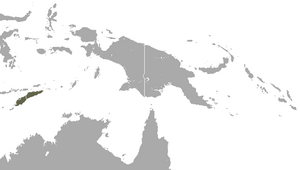Timor shrew facts for kids
Quick facts for kids Timor shrew |
|
|---|---|
| Conservation status | |
| Scientific classification | |
| Genus: |
Crocidura
|
| Species: |
tenuis
|
 |
|
| Timor shrew range | |
The Timor shrew (Crocidura tenuis), also known as the thin shrew, is a small mammal. It belongs to the shrew family called Soricidae. This special animal lives only on the island of Timor. This means it is endemic to Timor, which means it's found nowhere else in the world naturally. Sadly, the Timor shrew is facing a threat: its home is disappearing. This is called habitat loss, and it happens when forests or other natural areas are destroyed.
Contents
What is a Shrew?
Shrews are tiny, mouse-like mammals, but they are not rodents. They are more closely related to moles and hedgehogs. Shrews are known for their very high metabolism, which means their bodies burn energy quickly. Because of this, they need to eat a lot of food all the time to stay alive. Most shrews eat insects, worms, and other small creatures.
Where Does the Timor Shrew Live?
The Timor shrew lives on the island of Timor. This island is part of Southeast Asia, located north of Australia. Timor is known for its diverse wildlife and unique ecosystems. The shrew prefers to live in forests and other natural areas where it can find food and shelter.
Why is its Habitat Disappearing?
The main reason the Timor shrew is in danger is habitat loss. This usually happens because of human activities. For example, forests might be cut down for farming, building houses, or getting wood. When their homes are destroyed, shrews lose their food sources and safe places to live. This makes it very hard for them to survive and have babies.
Protecting the Timor Shrew
Scientists and conservation groups are working to protect animals like the Timor shrew. This often involves protecting their natural habitats. By saving the forests and other wild areas on Timor, we can help ensure that the Timor shrew and many other unique species have a place to live for the future.
See also
- In Spanish: Crocidura tenuis para niños
Images for kids



